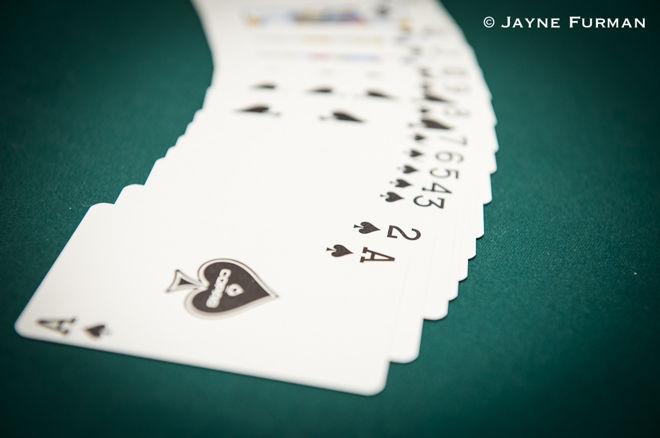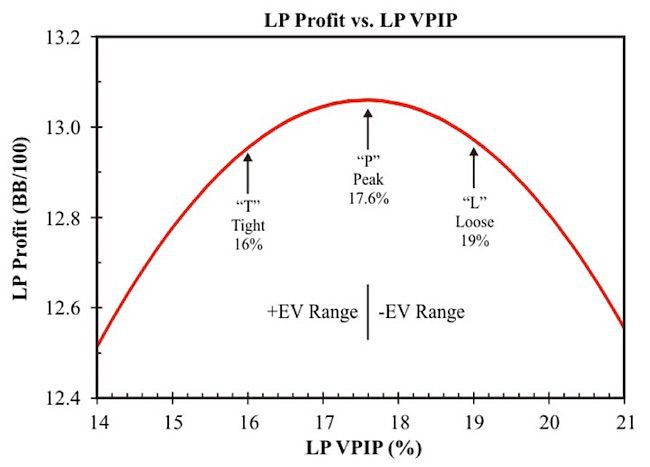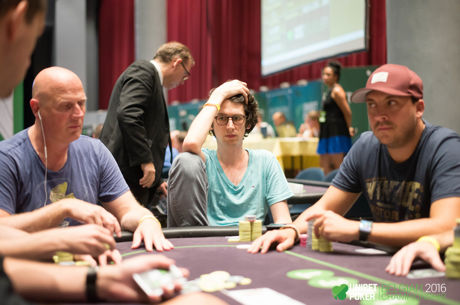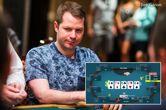Should We Balance Our Play in Low-Stakes Live No-Limit Hold'em?

The Wednesday Poker Discussion Group is held every week in Ricardo's restaurant in Las Vegas. We recently discussed a hand history where an excellent player said, "If I am going to three-bet with AxAx or KxKx here, I should also three-bet with my Kx10x-offsuit in order to balance my overall play."
I often hear similar comments at WPDG, on television poker broadcasts, and on the poker forums. This is one of my many poker pet peeves. It bothers me because I think that this "balance your play" wisdom rarely applies to the low-stakes live poker hands we normally discuss.
In fact, this advice can be downright harmful for these games.
This may sometimes be just a semantics issue, a sloppy description of what the pundit is really thinking. When he encourages us to "balance our play" he may actually mean we should "watch our frequencies."
But words matter. When we say one thing but mean something else, we make it harder to communicate what we are actually thinking. The less sophisticated listener might get the concept wrong.
Adjusting Our Frequencies
Balancing our play is not the same thing as adjusting our frequencies. Consider the curve depicted below, which shows Late-Position Profit versus Late-Position VPIP for online NL100. ("Late-Position" includes the hijack and cutoff seats, but not the button.)

This curve shows that our optimal "LP-VPIP frequency" for this game is 17.6 percent. But the precise location of the peak depends on the situation in which we find ourselves.
If we are playing in a Las Vegas $1/$2 game with four limpers ahead of us, the peak will shift to a higher frequency, meaning we can play a wider range. On the other hand, with a single raiser ahead of us, the peak will shift to a much lower frequency, which means we should play a tighter range.
So wherever the peak might be for our current situation and skill level, we lose value when we are off-frequency. For example, if we have been playing too loosely, we should adjust our frequency by folding our negative-EV hands.
This concept of adjusting our frequency applies to nearly every poker situation.
Suppose our optimal frequency for preflop three-betting in the cutoff is 3.8 percent. This could be a range of [JJ+, AK, AQs] = [3.3%] plus another [0.5%] for the occasional profitable three-bet bluff. We make these three-bets when we think it is our most profitable action in the current situation.
Yet the average Vegas $1/$2 player three-bets only 0.9 percent of the time, which might be only [KK+]. Mr. Average should adjust his three-bet frequency by adding hands which he can three-bet for value. If he is fairly unskilled, this might be just QxQx, JxJx and AxKx, so his optimal three-bet frequency might only be 3.0 percent. The greater his skill, or the weaker his opponents, the more hands he might be able to profitably three-bet.
Frequency errors abound in Vegas NLH. Most players are too loose, too passive, call too many raises and so forth. Our profit is generally maximized by exploiting their frequency errors while minimizing our own.
What Does "Balance our Play" Mean?
A cynical definition explaining why we should "balance our play" would be "we should make some bad plays to balance the good plays we normally make, because this confuses our opponents so they make more mistakes." I like this definition because it emphasizes the folly of balancing our play.
Less cynically, balancing our play means that we should sometimes make a negative-EV play in order to improve the profitability of our normal positive-EV plays. This makes us less predictable and therefore less exploitable.
Betting to balance our play could be understood as "betting to protect our overall strategy." Poker is a game of information and balancing provides less information to our opponents. They will make more mistakes if they are forced to make more guesses.
This is not the same as a passive player increasing his three-bet frequency by adding additional +EV hands. In fact, adjusting our frequencies (VPIP, CFPR, PFR, CBet or any other) in order to maximize profit is what we should always strive to do. Making a submaximal-EV play for balance is not the same thing.
Balancing our play means that we should sometimes make a negative-EV play in order to improve the profitability of our normal positive-EV plays. This makes us less predictable and therefore less exploitable.
The general approach to balancing our play is to play a wide range of hands in the same way and to play a particular strength hand (say, a set) in a variety of different ways. This makes it more difficult for an observant thinking villain to put us on a range.
Suppose we only three-bet preflop with our top 3 percent range, which might be [JJ+, AK]. An observant, thinking villain could safely fold his weakest holdings preflop or when he misses the flop. Adding AxQx-suited would be a reasonable frequency adjustment if we can do so profitably in the current situation. But adding a negative-EV hand like Kx10x-offsuit would be a balancing play, designed to confuse our opponents in a future situation.
Balancing our Play in Small Stakes Live Poker
Balancing our play is beneficial only if our opponents can exploit our imbalances. To do this they must first be able to detect our imbalances. Then they must be capable of exploiting them.
Consider an online $1/$2 NLH game. Players at this level often data mine their opponents by downloading every hand history they play. Then they use a Heads-Up-Display (HUD) to inform them of key statistical tendencies of their opponents. This information can be used to exploit an opponent's frequency errors and to clean up their own.
Note the emphasis on the word frequency. Adjusting our frequencies is not the same as balancing our play.
In principle, an opponent could review every hand to discover how we play in specific circumstances. For example, by filtering his database to look at three-bets, he might be able to determine what our three-betting range actually is. If we do not balance our three-bet range, we might be subject to exploitation.
But a fear of being unbalanced is usually not well-founded, even online. It not only requires a villain who data mines, he must also be able to find our imbalances. This can only happen if he has a large number of our hands and the motivation to search for imbalances. It's much more likely that Mr. HUD will simply monitor some of our key stats, hoping to exploit our frequency errors.
Low-stakes Vegas games are different. Even when playing against local regulars, there is no practical way for them to know whether we are balanced or not. Since our imbalances are rarely exposed and rarely noticed, balancing our play is really just a form of fancy play syndrome.
We are just wasting our money by advertising to the clueless if they can't (or won't) exploit our imbalances. At best, they will just guess at our imbalances, based on a general feeling about how we play.
Again, this is not the same as being off-frequency. We should endeavor to play optimal frequencies. But we can't fix a frequently made mistake by balancing a profitable play with a less profitable one.
A Vegas Example
I was playing $2/$5 at the Venetian in Las Vegas against totally unknown players. I was card dead for the first hour or so, playing only a few hands. Then I opened in middle position to $20 with pocket aces.
The unknown player in the hijack seat said (inappropriately), "You haven't played a hand yet — you must have aces." Nevertheless, he called, as did two other villains.
Mr. Hijack thought he detected an imbalance in my play, thinking that I would only open with a very strong hand. But Mr. Hijack can't possibly detect such an imbalance in just an hour or two. (Perhaps he realized this, so he called.)
And as demonstrated here, even when a local regular suspects an imbalance, he will rarely exploit it. This is a hallmark of low-stakes live no-limit hold'em games.
Some other Vegas Scenarios
Suppose we usually limp with small pairs in early position in a passive Vegas $1/$2 game. Then a hand comes up in which we are in EP and look down and find pocket aces.
The balancing meme whispers in our ear, telling us "we should sometimes limp with our aces to balance our play." But we would be losing value by doing this. Early position limping with aces might be +EV, but raising should be even more profitable.
Suppose an average player opens UTG+1. It folds to us in the hijack seat where we have K♥10♥. We normally three-bet with a 3.8 percent range in this situation, something like [TT+, AK, AQs]. The balancing meme suggests we can three-bet our K♥10♥ this time, even though it is nowhere close to our usual three-bet range.
But would our opponents ever notice that our three-bet range is unbalanced? Even though we are three-betting four times more often than our average opponent, this is still only once every 26 hands or so. If we add Kx10x-suited to our three-bet range, we will be three-betting light about once every 330 hands, or once every eight hours. And since we don't unnecessarily show our hand, our opponents are even less likely to see this. And even then, most won't even notice.
We shouldn't three-bet K♥10♥ unless it is our most profitable action in this situation.
Suppose we call a small preflop raise in the big blind with 10♣9♣, and the flop comes A♣Q♠8♣. Our standard line is to check-raise when we flop a strong draw out of position. This can be considered an unbalanced strategy, since an observant thinking player could exploit it. So, we sometimes check-call to balance our play.
But will a typical $1/$2 player notice this? Probably not! For one thing, this scenario does not come up very often. Furthermore, we sometimes also check-raise with a set or two pair, a play we make when it is our most profitable line. It would be very difficult for any live player to detect an imbalance in our check-raising strategy.
Suppose we call a small preflop raise and flop a set. The raiser continuation bets. A balanced strategy has us raising sometimes and calling the other times. And since we sometimes raise our flopped sets, we must also sometimes raise when we miss our set.
But making these adjustments in a Vegas game merely to balance our play is not an optimal strategy. We should raise our flopped set when it is our highest EV play in the current situation. When we miss the set, we should also make the play we think has the highest EV in the current situation.
Don't Balance Your Play
Balancing our play against the many weak players in order to be less exploitable by the rare strong player makes little sense (or profit). It's better to play a fully exploitive strategy, completely ignoring the fancy-play concept of balance.
The vast majority of low-stakes live players will never exploit our imbalances because they won't notice, won't care and won't know how to adjust. We will make much more money exploiting them than we might lose to the rare observant, thinking player.
Steve Selbrede has been playing poker for 20 years and writing about it since 2012. He is the author of five books, The Statistics of Poker, Beat the Donks, Donkey Poker Volume 1: Preflop, Donkey Poker Volume 2: Postflop, and Donkey Poker Volume 3: Hand Reading.









